 This particular lady is one who has come close to being written out of history, and it’s about time she was put back in. It is partly because she is so obscure that I think her movie should be done as a sequel to one on her father, Alfred the Great who, though better known, also deserves more recognition and is definitely worthy of a movie in his own right.
This particular lady is one who has come close to being written out of history, and it’s about time she was put back in. It is partly because she is so obscure that I think her movie should be done as a sequel to one on her father, Alfred the Great who, though better known, also deserves more recognition and is definitely worthy of a movie in his own right.
By the 9th Century AD the southern part of the island of Great Britain had been taken over by Germanic tribes known collectively as the Anglo-Saxons. Missionaries had converted them to Christianity and the original seven kingdoms had merged into three. To the north was Northumbria; to the east and centre was Mercia, which included the area settled by the Angles; Alfred’s kingdom was Wessex, land of the West Saxons, and covered the area to the west and south.
This period is often called the Dark Ages, and when the Great Viking Army arrived in must have seemed to many Christians that it was about to get even darker. The invaders still worshipped old gods such as Tiw (Tyr), Odin (Woden), Thor and Freya who had held sway over Germany and Scandinavia for centuries. [The spelling varied in the different areas, but evidence of their is still to be seen in the days that bear their names; Tuesday, Wednesday, Thursday and Friday.]
From this complex mythology, only the Valkyries survive. They were originally the “shield maidens” of Odin who rode into battles to bring the bravest of the fallen to Valhalla. In modern times they are seem in many forms, standard bearers of a near forgotten culture that have been absorbed into our own. Personally, I’m glad they are still with us, for I rather like them and would love to see a fantasy sequence involving them included in the movie.
The invaders quickly overran Northumbria, although the film would only mention this in passing. It would concentrate on the struggle for survival of the two southern kingdoms against the Danish Vikings, thought of by the monastic chronicles of the time, as the forces of darkness. The Danes also believed in magic, and their mythology was full of tales about rings of power or doom, such as Andvarinaut, a cursed ring that blighted many lives. If all this sounds familiar to Lord of the Rings fans, it is hardly surprising: J.R.R. Tolkien was professor of Anglo Saxon studies at Oxford University.
 While he got his inspiration from many sources (and did not welcome speculation on such matters!), it is, however, hard to ignore certain similarities between Middle Earth and Anglo Saxon England. For example both had: just one woman to fight on horseback; one woman to lead men in battle; one woman to help rule her people when destiny called. Taking everything into consideration, it is quite likely that the legends of Aethelflaed, Lady of the Mercians, inspired Tolkien to crate Eowyn, Lady of the Rohan (left). I do admit, that this similarity seems to relate more to their character, rather than to the lives they led in fact and fiction.
While he got his inspiration from many sources (and did not welcome speculation on such matters!), it is, however, hard to ignore certain similarities between Middle Earth and Anglo Saxon England. For example both had: just one woman to fight on horseback; one woman to lead men in battle; one woman to help rule her people when destiny called. Taking everything into consideration, it is quite likely that the legends of Aethelflaed, Lady of the Mercians, inspired Tolkien to crate Eowyn, Lady of the Rohan (left). I do admit, that this similarity seems to relate more to their character, rather than to the lives they led in fact and fiction.
When Aethelflaed was born in 869 her uncle, Aethelred was King. These were troubled times and Alfred was soon helping his brother lead the army of Wessex against the invaders. The Vikings had been raiding Britain for many years but this army was a much more dangerous proposition – they had come to stay. In 871, Aethelred died of wounds received in battle and Alfred became King. He fought the Danes to a standstill and kept Wessex the only area free of them, but at a heavy price: part of the peace settlement involved paying off the Danes, which Alfred reluctantly did. His little kingdom was exhausted and he knew that if he was killed in battle, there was nobody to follow him. But this only bought him five years. The Danes started encroaching on Wessex and in January 878, launched a winter offensive which took the Saxons completely by surprise. The whole of Wessex was overrun and the royal family was forced to flee, fugitives in their own land.
A lesser man would have quit – the King of Mercia fled to Europe when his kingdom was overrun. Alfred was made of sterner stuff, and this became his finest hour. He went to the Somerset marshes and four months later had transformed a ragged band of followers into an army which defeated the Danes at the battle of Edington. A movie about Alfred would pay particular attention to this period, and I don’t think it unreasonable to assume that Aethelflaed would want to help her father in his time of need. He organised guerrilla warfare against the Danes, and I would include a scene in which eight-year old Aethelflaed spies on them. She is spotted and chased, but gets away. As they give up the chase our little heroine hears them remark; “These Saxon brats are just like their King, good at running and hiding.” We have a close up of a dirty but fiercely determined little face. “When I am grown up, it is you who will be running and hiding from me,” she says passionately.
When Aethelflaed gets back to camp she finds her mother Ealswyth frantic with worry. Everybody had been out looking for her and she was in big trouble – Alfred towers above her, and demands to know where she has been. When he finds out she has been spying on a group of Danes that were in the marshes he is furious, but when he stops yelling long enough to listen he realises that the information his daughter has brought him is extremely valuable. It’s difficult to stay angry with someone of whom you are very proud… After his decisive victory Alfred was able to dictate peace on his terms, which included the partition of Mercia. He achieved a lot, but I don’t anticipate his movie spending much time on them. There would still have been troubles with the Danes, who were a collection of independent bands rather than a true army, as we would understand it.
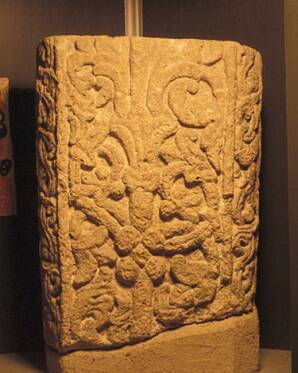
Aethelflaed’s gravecover in Gloucester
At the age of twenty, Aethelflaed married Ethelred, a powerful noble of Mercia and long-time friend of her father. They ruled together, but were never officially known as King and Queen, since many people were still waiting for the return of the King of Mercia from exile. A scene involving Ethelred finding out first hand that she knows how to fight would be a must. I like the idea of them being ambushed while travelling through a forest. Aethelflaed is travelling by wagon but when the Danes attack, her husband ignores her protests and gives her his horse. He tells her to ride on and sends half their bodyguard with her as protection. A short distance away she stops, and notices that the outnumbered Saxons are in trouble. She tries to send the men with her back, but they reluctantly refuse – their orders are to stick with her. Aethelflaed smiles, turns her horse and charges into the fight, picking up a sword from a fallen warrior on the way. The men have no alternative but to follow her; the Danes are taken completely by surprise and after a spirited scrap are beaten off.
Towards the end of the century the Danes attacked again but the combined efforts of Wessex and Mercia drove them back. Alfred was quite sick by this time and although he had organised the defence, such as the creation of a navy, the actual fighting was left to the younger generation. In 899 Alfred died and his son Edward became King of Wessex. The two countries continued to cooperate as before, and together increased the area of Mercia held by the Anglo-Saxons.
 After her husband died in 911, Aethelflaed ruled alone until she died in 918 – he had been sick for some while before this, so in reality she already had the reins. In these last few years she is reported to have led her army in battle against the Vikings, recaptured the town of Derby without a siege, skilfully negotiated treaties with the Danes, Scots and Welsh, and built fortifications – her street plan can still be seen today in the town of Gloucester, where she also rebuilt the Roman walls. Though final victory went to others, without Aethelflaed’s tactical prowess to pave the way, the task of those who followed would have been much harder, if not impossible. [Picture at left is Skeggjold, one of a serious of Valkyrie dolls created by Tanya Van Der Ploeg – for more information visit her website.]
After her husband died in 911, Aethelflaed ruled alone until she died in 918 – he had been sick for some while before this, so in reality she already had the reins. In these last few years she is reported to have led her army in battle against the Vikings, recaptured the town of Derby without a siege, skilfully negotiated treaties with the Danes, Scots and Welsh, and built fortifications – her street plan can still be seen today in the town of Gloucester, where she also rebuilt the Roman walls. Though final victory went to others, without Aethelflaed’s tactical prowess to pave the way, the task of those who followed would have been much harder, if not impossible. [Picture at left is Skeggjold, one of a serious of Valkyrie dolls created by Tanya Van Der Ploeg – for more information visit her website.]
Her daughter briefly ruled after her death, but Edward took over when he found she was not up to the job, and ruled the two kingdoms as one until his death, when his son Aethelstan succeeded him. At a very young age Aethelstan was sent to Mercia where his Aunt Aethelflaed raised him, another potential plot thread. Mercia became his home and it is only natural that he would become their next king – the kingdoms were never separated again. Aethelstan continued the family tradition of gaining land from the Danes and finished up controlling the whole country, having taken over the Danish kingdom centred on York. A good indication of how close he was to his aunt is the statue of Aethelflaed that stands in the grounds of Tamworth Castle. Her right hand firmly grips a sword, but her left arm is protectively draped around the child Aethelstan.
In my view, Alfred, Aethelflaed, Edward and Aethelstan should be looked at collectively as the family that created England as a nation. I have no problem with Alfred becoming known as “The Great”, many years after his death, but think it only fair to point out that without his daughter, son and grandson, his efforts would not have had much lasting effect. Aethelflaed in particular has been relegated to a mere footnote, or worse still completely ignored, and the time is long overdue to do something about it.
A sequel to Alfred’s movie could feature Aethelflaed, though the basis for this would be neither the list of battles fought and fortifications built on the web, nor stuff that I make up. It should be based on the legends of Aethelflaed, which for some reason have been lost over the centuries. When William the Conqueror successfully invaded England in 1066 he cared little for his immediate predecessors, but found many stories still being told of Alfred and his warrior daughter. What better way to legitimise his rule than by marrying Matilda of Flanders, a direct descendant of Elfthryth, Aethelflaed’s sister? This connected William to the legends and enabled his descendants to trace their line right back to Alfred.
I saw one such descendant not long ago, hosting a documentary on the History channel. The credits referred to him as Edward Windsor, but we know him better as Prince Edward, Queen Elizabeth II’s youngest son. Further evidence of his interest in history is the title he took on marriage: Earl of Wessex. His brothers have secondary titles to give their wives rank too, but neither went back over a thousand years to find them. Sounds to me like the right person to go digging in the royal archives, and see if he can find anything about Aethelflaed’s legends…

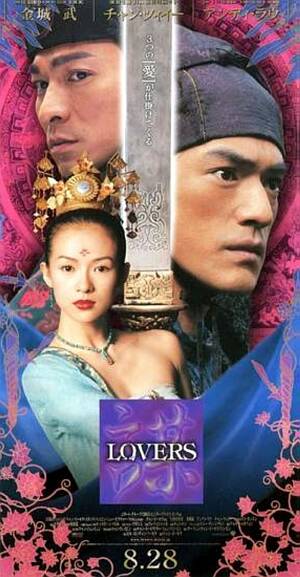 Since the success of Ang Lee’s Crouching Tiger, fellow arthouse director Zhang Yimou seems to have become obsessed with one-upping Lee. First was Hero, a sumptuous and multi-levelled tale of revenge and betrayal starring Jet Li; now, we get House which while slightly smaller in scale, is clearly going for the same tragically romantic feel as CTHD. Policeman Leo (Lau) suspects Mei (Zhang), an arrested blind prostitute, is part of the titular rebel group, so sends Jin (Kaneshiro) to win her confidence by helping her ‘escape’, then going with her to the Flying Daggers’s base. However, it gives nothing away to say that Mei and Jin start having feelings for each other, as they battle through the countryside, and it’s no surprise to discover that several other characters aren’t what they seem either.
Since the success of Ang Lee’s Crouching Tiger, fellow arthouse director Zhang Yimou seems to have become obsessed with one-upping Lee. First was Hero, a sumptuous and multi-levelled tale of revenge and betrayal starring Jet Li; now, we get House which while slightly smaller in scale, is clearly going for the same tragically romantic feel as CTHD. Policeman Leo (Lau) suspects Mei (Zhang), an arrested blind prostitute, is part of the titular rebel group, so sends Jin (Kaneshiro) to win her confidence by helping her ‘escape’, then going with her to the Flying Daggers’s base. However, it gives nothing away to say that Mei and Jin start having feelings for each other, as they battle through the countryside, and it’s no surprise to discover that several other characters aren’t what they seem either.




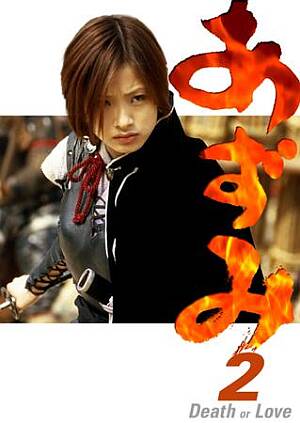 I went into this with low expectations, based on some scathing reviews and the lack of Ryuhei Kitamura, whose directorial style made the first such a joy. I’m pleased to report then, that this surpassed expectations, with some nice imagination and a bevy of action heroines (including Kuriyama, whom you’ll know as Gogo Yubari from Kill Bill, Volume 1), as well as the expected high body-count. It follows on loosely from the original, but heads in a slightly different direction; our heroine is still intent on her mission, but is diverted by a wandering samurai, part of a rogue gang, who reminds her of Nachi, her childhood friend she had to kill at the opening of the original film.
I went into this with low expectations, based on some scathing reviews and the lack of Ryuhei Kitamura, whose directorial style made the first such a joy. I’m pleased to report then, that this surpassed expectations, with some nice imagination and a bevy of action heroines (including Kuriyama, whom you’ll know as Gogo Yubari from Kill Bill, Volume 1), as well as the expected high body-count. It follows on loosely from the original, but heads in a slightly different direction; our heroine is still intent on her mission, but is diverted by a wandering samurai, part of a rogue gang, who reminds her of Nachi, her childhood friend she had to kill at the opening of the original film.
 Perhaps I was expecting too much, after reading reviews that
Perhaps I was expecting too much, after reading reviews that  This particular lady is one who has come close to being written out of history, and it’s about time she was put back in. It is partly because she is so obscure that I think her movie should be done as a sequel to one on her father, Alfred the Great who, though better known, also deserves more recognition and is definitely worthy of a movie in his own right.
This particular lady is one who has come close to being written out of history, and it’s about time she was put back in. It is partly because she is so obscure that I think her movie should be done as a sequel to one on her father, Alfred the Great who, though better known, also deserves more recognition and is definitely worthy of a movie in his own right. While he got his inspiration from many sources (and did not welcome speculation on such matters!), it is, however, hard to ignore certain similarities between Middle Earth and Anglo Saxon England. For example both had: just one woman to fight on horseback; one woman to lead men in battle; one woman to help rule her people when destiny called. Taking everything into consideration, it is quite likely that the legends of Aethelflaed, Lady of the Mercians, inspired Tolkien to crate Eowyn, Lady of the Rohan (left). I do admit, that this similarity seems to relate more to their character, rather than to the lives they led in fact and fiction.
While he got his inspiration from many sources (and did not welcome speculation on such matters!), it is, however, hard to ignore certain similarities between Middle Earth and Anglo Saxon England. For example both had: just one woman to fight on horseback; one woman to lead men in battle; one woman to help rule her people when destiny called. Taking everything into consideration, it is quite likely that the legends of Aethelflaed, Lady of the Mercians, inspired Tolkien to crate Eowyn, Lady of the Rohan (left). I do admit, that this similarity seems to relate more to their character, rather than to the lives they led in fact and fiction.
 After her husband died in 911, Aethelflaed ruled alone until she died in 918 – he had been sick for some while before this, so in reality she already had the reins. In these last few years she is reported to have led her army in battle against the Vikings, recaptured the town of Derby without a siege, skilfully negotiated treaties with the Danes, Scots and Welsh, and built fortifications – her street plan can still be seen today in the town of Gloucester, where she also rebuilt the Roman walls. Though final victory went to others, without Aethelflaed’s tactical prowess to pave the way, the task of those who followed would have been much harder, if not impossible. [Picture at left is Skeggjold, one of a serious of Valkyrie dolls created by Tanya Van Der Ploeg – for more information visit
After her husband died in 911, Aethelflaed ruled alone until she died in 918 – he had been sick for some while before this, so in reality she already had the reins. In these last few years she is reported to have led her army in battle against the Vikings, recaptured the town of Derby without a siege, skilfully negotiated treaties with the Danes, Scots and Welsh, and built fortifications – her street plan can still be seen today in the town of Gloucester, where she also rebuilt the Roman walls. Though final victory went to others, without Aethelflaed’s tactical prowess to pave the way, the task of those who followed would have been much harder, if not impossible. [Picture at left is Skeggjold, one of a serious of Valkyrie dolls created by Tanya Van Der Ploeg – for more information visit 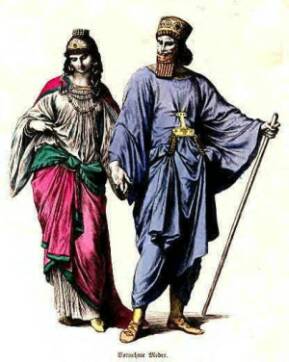 There were actually two queens of Halicarnassus called Artemisia. In the 4th century BC, one built a mausoleum to her husband, that was so beautiful that it became acknowledged as one of the Seven Wonders of the World, but she was the later, and at least for our purposes, the secondary holder of the name. Her predecessor’s time in the spotlight came during the Battle of Salamis, in the year 480 BC – the story of how she arrived there, leading a squadron of ships, would occupy the bulk of the movie, with the battle as the climax. Artemisia had married the King of Halicarnassus about twenty years earlier and when he died a few years later, took the throne for herself.
There were actually two queens of Halicarnassus called Artemisia. In the 4th century BC, one built a mausoleum to her husband, that was so beautiful that it became acknowledged as one of the Seven Wonders of the World, but she was the later, and at least for our purposes, the secondary holder of the name. Her predecessor’s time in the spotlight came during the Battle of Salamis, in the year 480 BC – the story of how she arrived there, leading a squadron of ships, would occupy the bulk of the movie, with the battle as the climax. Artemisia had married the King of Halicarnassus about twenty years earlier and when he died a few years later, took the throne for herself. The Persian Empire was a huge collection of diverse races united only in the tributes they paid to Xerxes. A select group of these subservient allies plus some of his own officials made up his military council. Artemisia was a member of the council and she alone spoke against taking on the Athenians in a naval battle. She advised him that the fleet would be better employed in supporting the army. Athens had already been occupied, and the whole of Greece lay open, but if the Persian fleet were decisively defeated, most of the army would have to withdraw as it could no longer be supplied from the sea. She wasn’t predicting disaster – but she wasn’t ruling it out either and considered it not worth the risk.
The Persian Empire was a huge collection of diverse races united only in the tributes they paid to Xerxes. A select group of these subservient allies plus some of his own officials made up his military council. Artemisia was a member of the council and she alone spoke against taking on the Athenians in a naval battle. She advised him that the fleet would be better employed in supporting the army. Athens had already been occupied, and the whole of Greece lay open, but if the Persian fleet were decisively defeated, most of the army would have to withdraw as it could no longer be supplied from the sea. She wasn’t predicting disaster – but she wasn’t ruling it out either and considered it not worth the risk. It has been recorded that Xerxes watched from the beach and when Artemisia rammed her rival exclaimed, “The men behaved like women, and the women like heroes.” It has been suggested that Xerxes was unaware of who she rammed, but I don’t buy this. Calling it a Persian fleet is done as a convenience, because describing it as a combined Phoenician, Egyptian, Cypriot, Cilician and Ionian-Greek fleet, is so cumbersome. Persia was a land empire and called on its allies and vassal states to provide ships. These were peoples who were natural rivals most of the time and would need little incentive to start fighting each other, especially as they try and escape the Greek trap. Artemisia only did what everyone else was trying to do – she just did it with style. The recognised facts support this view: after the battle, she remained on good terms with Xerxes while most of the fleet, and Xerxes himself, returned to their home countries
It has been recorded that Xerxes watched from the beach and when Artemisia rammed her rival exclaimed, “The men behaved like women, and the women like heroes.” It has been suggested that Xerxes was unaware of who she rammed, but I don’t buy this. Calling it a Persian fleet is done as a convenience, because describing it as a combined Phoenician, Egyptian, Cypriot, Cilician and Ionian-Greek fleet, is so cumbersome. Persia was a land empire and called on its allies and vassal states to provide ships. These were peoples who were natural rivals most of the time and would need little incentive to start fighting each other, especially as they try and escape the Greek trap. Artemisia only did what everyone else was trying to do – she just did it with style. The recognised facts support this view: after the battle, she remained on good terms with Xerxes while most of the fleet, and Xerxes himself, returned to their home countries A combination of the seventh and eighth in the series, I believe it’s the first entry (I don’t
A combination of the seventh and eighth in the series, I believe it’s the first entry (I don’t  Director Ichimura returned for the fourth episode, and despite similar problems as the third installment – most obviously, an apparent doubt that Oichi’s character can hold the viewer’s interest by herself – makes a much better stab at things here. Bounty-hunter Oichi finds out what life is like on the other side of the law, after she helps rescue an unwilling bride from a local magistrate; he slaps a 100 gold-piece reward on her head, which naturally, brings other bounty-hunters on her trail, led by Sankuro (Meguro).
Director Ichimura returned for the fourth episode, and despite similar problems as the third installment – most obviously, an apparent doubt that Oichi’s character can hold the viewer’s interest by herself – makes a much better stab at things here. Bounty-hunter Oichi finds out what life is like on the other side of the law, after she helps rescue an unwilling bride from a local magistrate; he slaps a 100 gold-piece reward on her head, which naturally, brings other bounty-hunters on her trail, led by Sankuro (Meguro).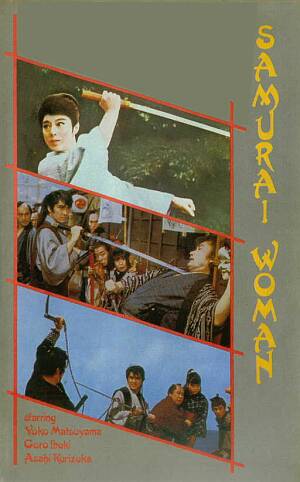 The third entry in the series saw a new director, and unfortunately, a marked turn for the worse, largely because the focus drifts off Oichi. It starts briskly enough, with the heroine coming into possession of a new, effective formula for gunpowder, something barely known at the time in Japan. Understandably, this makes her the focus of attention, in particular for a group with an interest in profiting from the discovery.
The third entry in the series saw a new director, and unfortunately, a marked turn for the worse, largely because the focus drifts off Oichi. It starts briskly enough, with the heroine coming into possession of a new, effective formula for gunpowder, something barely known at the time in Japan. Understandably, this makes her the focus of attention, in particular for a group with an interest in profiting from the discovery.